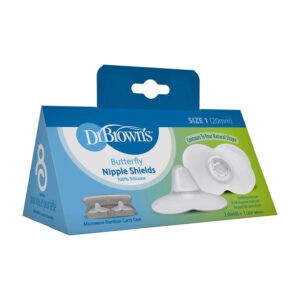A nipple shield is a simple item that can have a major impact on breastfeeding.
It is a nipple-shaped sheath worn over the areola and nipple during breastfeeding. It is made of a soft, thin, flexible silicone shield. It should have holes at the end of the nipple section to allow breast milk to pass through into baby’s mouth while feeding. As a breastfeeding parent, you apply it to your nipple like a suction cup, so the shield will keep the nipple erect and help baby get a deep latch while minimizing or eliminating your pain.
When would I need to use a nipple shield?
As an International Board Certified Lactation Consultant (IBCLC), I recommend that my clients try breastfeeding without a nipple shield in the beginning. A lot of breastfeeding parents who have flat or inverted nipples think they will automatically need to use a shield when their baby arrives. In most cases, however, we can work with a baby to set up a deep latch and a strong suck. This will help bring out the nipple while the baby is breastfeeding.
In some cases, babies still need a nipple shield if they have a weak suck or are unable to get a deep latch. IBCLCs are especially helpful in this case because they can evaluate the issue and create a plan on how to wean off the nipple shield.
Sore nipples from a “bad” latch also present an opportunity for nipple shields to help. Some moms use them as a short-term solution to help heal their nipples while still continuing to nurse their baby.
Overall, nipple shields are great to help and guide breastfeeding—but it’s best for parent and baby to ensure the latch is the best it can be.
How do I use a nipple shield properly?
Correct application and usage of nipple shields should not cause any issues to milk transference or maintenance of breast milk supply. But the application and use must be done right in order to help, and not hinder, breastfeeding.
If you are not using a nipple shield correctly it can decrease stimulation at the breast, which sets up your breast milk supply to decrease. I recommend wetting the nipple shield slightly before applying it to the breast. Also, you can create suction by inverting the nipple shield halfway and pressing it against your skin. Many resources online can teach you this technique. You may hear a “pop” when it is applied correctly. To test it, give the nipple shield a little tug; it should not come off easily.
If you have flat or inverted nipples, the shield should pull out more of your nipple while the baby is suckling. This signals a correct application. Nipple shields also come in different shapes and sizes. If you ever have doubts that you are applying the nipple shield correctly or using the right size, reach out to an IBCLC for help!
When should I wean off the nipple shield?
Nipple shields are typically recommended for short-term use, so lactation consultants will often create a plan with you to wean your baby off the shield.
My favorite “IBCLC trick” for weaning off the nipple shield is starting a feed with the shield on, and then halfway through the feeding, pulling the shield off and re-latching baby quickly to your bare breast.
(If you are using a nipple shield for your entire breastfeeding journey and it works for you and baby, that’s okay too. Support is available if you want to stop using the shield at any point.)
When do I need to replace a nipple shield?
Since nipple shields are usually temporary in a mom’s journey, one nipple shield can be sufficient. But, since they are small, clear—and honestly, easy to lose—I recommend you having a couple on hand just in case. (Some come with a storage case, which is super helpful.) If using the nipple shield for long term use, I would recommend replacing them at the first sight of wear and tear, just as you would for any bottle nipple.
When should I reach out to an IBCLC when using a nipple shield?
If you’re able to do so, I recommend connecting with an IBCLC as soon as you start using a nipple shield—and definitely if you continue to struggle with breastfeeding. An IBCLC will make sure you are applying the shield correctly, will make sure the baby is transferring enough milk via the shield, and will make sure your supply is not affected by using the shield. Importantly, the lactation consultant will help you figure out the root of your breastfeeding issue that’s leading to nipple shield use.
You should never feel guilty for using a nipple shield. It can be a vital tool to enable breastfeeding to strengthen and continue, no matter how long a parent uses it.
About the author:
Leana L. Thompson, RN, BSN, IBCLC
Leana is a Registered Nurse, an International Board Certified Lactation Consultant, and a mom of two little girls under age 2. She lives in Gilbert, Arizona, where she owns her own business, LactationNow. She worked as a Mother-Baby RN for nearly a decade in hospitals all across the United States. Leana offers in-home and virtual lactation consultations. LactationNow’s goal is to provide services that give you and your partner the ultimate mother-baby experience before and after you leave the hospital. She covers prenatal breast consults, weaning consults, and everything in between. She also shares pumping and breastfeeding tips and tricks on her social media (@lactationnow) to support families across the globe. Contact Leana at Leana@lactationnow.com for virtual or in person IBCLC support.

